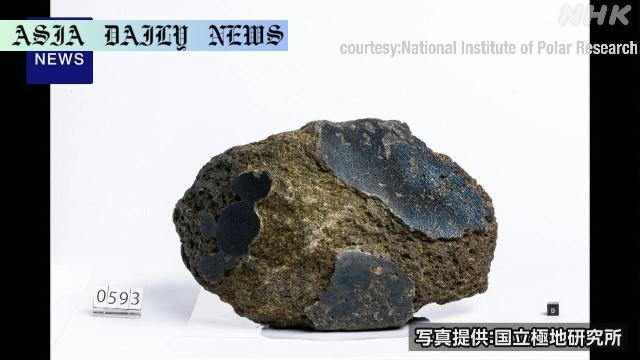Mars rock: A prized meteorite from Mars, discovered in Antarctica, to be displayed publicly for the first time at Osaka Expo 2025.
A Mars rock, weighing 13 kilograms and the size of a rugby ball, will be displayed at the Osaka Expo 2025.
The meteorite was discovered in Antarctica by a Japanese expedition team and is one of the largest of its kind.
This marks the first public exhibition of the meteorite at the Japan Pavilion until the Expo’s closure in October.
The exhibit draws parallels with the popular Moon rock display during the 1970 Osaka Expo.
Organizers aim to inspire visitors to reflect on the universe and Earth’s wonders.

An Unveiling of Stellar Proportions: The Mars Rock’s Journey
A piece of Mars is set to make history by going on display during the Osaka Expo 2025, an event already promising to blend innovation and inspiration. This 13-kilogram meteorite, roughly the size of a rugby ball, is no ordinary rock. This meteorite, thought to have reached Earth tens of thousands of years ago, was discovered by a Japanese expedition team in Antarctica back in 2000. Since then, it has been kept safely at the National Institute of Polar Research in Tokyo, awaiting its moment of prominence.
This Mars rock is one of the largest meteorites of its kind known in the world, making it an unparalleled exhibit. For years, it has been an item of extensive scientific research, offering clues about the Red Planet’s geology and its past. Finally, the general public has the once-in-a-lifetime opportunity to behold this extraordinary artifact during its first-ever public unveiling.
A Nod to the Past: Echoes of 1970’s Moon Rock Display
The Mars meteorite’s presentation at the Osaka Expo 2025 pays homage to an iconic moment from the 1970 Expo, during which a Moon rock captured imaginations and brought visitors a sense of wonder about outer space. According to Kumagai Hiroyasu, the head of public relations at the National Institute of Polar Research, this display feels almost fateful, as though the stars have aligned to present another cosmic spectacle. It’s a poignant reminder of humanity’s enduring fascination with space and our planet’s connection to celestial objects.
By making such rare marvels accessible to the public, these expos aim not only to showcase scientific breakthroughs but also to spark curiosity and reflection among visitors. The Mars rock, glowing under the spotlight at the Japan Pavilion, is expected to be one of the Expo’s standout attractions.
Inspiring Awe and Reflection Among Visitors
One crucial goal behind the Mars rock exhibit is to inspire onlookers to think about their place within the cosmos. By observing this fragment of another planet, visitors might develop a greater appreciation for Earth’s uniqueness and its connection to the universe. The meteorite’s journey to Earth, spanning millennia and unimaginable distances, is a testament to the mysterious and interconnected nature of the cosmos.
Osaka Expo organizers hope this exhibit leaves a lasting impression, just as the Moon rock did decades ago. When people see a piece of Mars up close, they are encouraged to think beyond the confines of our planet and consider the broader implications of space exploration and planetary science. From young schoolchildren to seasoned researchers, the Mars rock is certain to spark conversations and dreams about humanity’s future among the stars.
Securing the Future: Mars Rock’s Legacy
While the meteorite serves as a captivating exhibit, it is also a representation of Japan’s dedication to space science and their consistent contributions to exploration and research. As interest in Mars exploration grows, particularly with numerous missions aiming to study the planet further or even send humans, this exhibit symbolizes humanity’s endless drive to explore the unknown. From its unearthing in the frozen landscapes of Antarctica to its impending display at the bustling Osaka Expo, this meteorite’s journey has been as exceptional as its origin story.
In the months to come, the Osaka Expo 2025 and its pioneering exhibits like this Mars rock will undoubtedly inspire awe, knowledge, and a sense of interconnectedness with the cosmos, leaving a legacy for generations.
Commentary
The Significance of Space Exhibits for Public Inspiration
The decision to display the Mars rock at the Osaka Expo 2025 is profound and timely. At a time when space exploration is rapidly advancing with missions to the Moon, Mars, and beyond, public exhibits like this forge a vital connection between groundbreaking science and general awareness. Viewing a tangible piece of another planet allows individuals, especially younger generations, to feel a personal connection to the mysteries of the universe. It essentially breaks down abstract scientific pursuits, making them relatable and engaging for the everyday audience.
An Artifact That Transcends Time and Space
One of the most beautiful aspects of the Mars meteorite on display is its inherent storytelling. This rock, which traveled from Mars to Earth tens of thousands of years ago, is much more than a scientific relic—it is a silent witness to planetary histories and cosmic journeys that span epochs. Exhibiting such an item at an event like the Expo contextualizes science’s grandeur and reminds us of the long continuum of existence, much beyond human timelines. This, in itself, is an awe-inspiring perspective.
Fostering Wonder and Encouraging Scientific Inquiry
Ultimately, the Mars rock exhibit offers more than a chance to marvel at a rare artifact; it serves as a gateway to deeper inquiries. What does the meteorite tell us about Mars’s geology and history? Could it lead to better understanding of life outside Earth? These are questions that will likely permeate conversations at the Expo and beyond. Most importantly, such initiatives underline the importance of public engagement and education in science, ensuring that curiosity and learning remain central to our journey toward understanding the universe.


